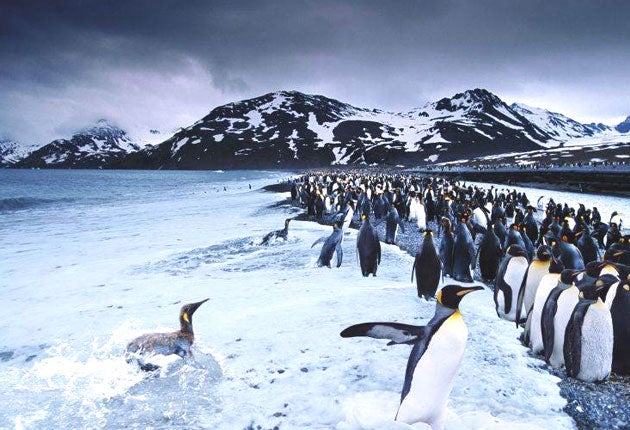The Antarctic island that's richer in biodiversity than the Galapagos
Divers last year came up with so many examples of sea life that they still don't know how many they found

An "inhospitable lump of rock" several days sailing from the nearest civilisation has been revealed as more valuable to wildlife than the Galapagos Islands.
South Georgia is the last stop before the icy wastes of the Antarctic and is battered by the elemental forces of the Southern Ocean. Yet beneath the surface of the chill waters that surround the island lives a greater range of wildlife than on the Galapagos, which seemingly offers a much more benign environment.
The first comprehensive survey of the waters of South Georgia, a UK overseas territory, has revealed that despite being just 600km (373 miles) from the Antarctic Peninsula, it boasts 1,445 recorded species.
Many of them are found nowhere else in the world and most of them are rare. They include fish, sea urchins, free-swimming worms, sea spiders and a host of crustaceans. Some are vast, such as the sperm whale, killer whale and blue whale. More than half the world's elephant seals breed there and South Georgia is the most important nest site for king penguins.
Being found in cold waters many of the animals are slow-growing, making the eco-system fragile because losses take so long to be replaced.
Oliver Hogg, one of the research team at the British Antarctic Survey (BAS), said: "It shows you don't have to be a tropical island or in a hot part of the world to support a lot of marine life. These lumps of rock may look inhospitable and cold but once you are under the surface of the water they can support a diverse eco-system. South Georgia, in terms of the number of species, is the richest place known in the Southern Ocean. It has more reported species than have been shown to occur on the Galapagos Islands, which are examples of really rich diversity."
Almost 1,500 species were identified in the region through analysis of records produced in 130 years of research in the Antarctic. While some date back more than a century, many species are only now being detected off South Georgia.
Divers investigated two areas of the sea close to South Georgia at the end of last year and came up with so many examples of sealife that they still don't know how many they found. "They turned up a ridiculous amount of specimens which they are still working their way through. It looks like they have found a lot of species we didn't know were at South Georgia," Mr Hogg said.
More dives are planned for later this year off the southern side of the island, which is the least known and explored area, and it is quite possible that researchers will find creatures that are unknown to science.
There are several reasons why South Georgia is so rich in wildlife. It's remoteness and lack of human interference helps but the chief reasons are thought to be the age of the island and its positioning by currents which transport nutrients – and new species – from cold and warm waters.
Mr Hogg, a marine ecologist, said: "One of the reasons it's so rich is, we suspect, that it's a really old island. It separated from the continental land mass of South America and Antarctica about 45 million years ago so it's had a lot of time to evolve new species and develop a really diverse ecosystem."
The information put together by the BAS team, which was part-funded by the South Georgia Heritage Trust and the Darwin Initiative, will be used as a source against which changes to the spread and quantity of wildlife in the region can be assessed. The study is published by online journal PLoSONE.
Of particular concern is the rising temperature of the sea water, at least some of which is thought to be attributable to man-made climate change, which could have a devastating effect on the type of life on the sea floor.
In the period 1925 to 2006 sea temperatures in the region rose on average by 0.9C in January and 2.3C in August in the 100 metres of water nearest the surface. Warming is much less marked in deeper regions.
South Georgia was claimed by the UK in 1775 when Captain James Cook made the first landing on the island. It was briefly seized from British control by Argentina in the 1982 Falklands war. Scientists are among the few people who live on the island which has no native population.
Sea spider
In Antarctic waters, sea spiders can grow far bigger than their European relatives. One species, Decolopoda australis, reaches 30cm across and can live for decades. They are thought to feed on sponges and other creatures living on the sea bed.
Brittle star
Similar to and closely related to starfish, they crawl across the seabed searching for food and can reach depth of more than 2,000m. Bits of their arms break off easily, which is how they get their name. They eat and excrete through the same orifice.
South Georgia ice fish
These can grow up to 60cm long and can weigh more than 2kg. They eat mainly krill and smaller fish. They are numerous enough for a fishery to be sustained and managed by the South Georgia government.
Sponge
South Georgia has 81 species and three per cent of these are exclusive to the island. They can regenerate from broken fragments and extract food and oxygen from water pumped through their bodies.
1,800 Distance, in kilometres, from the South American continental shelf.
1,445 species have been recorded in the waters off the island.
90 per cent of the world's fur seals live in South Georgia – an estimated 5.4 million of them.
Join our commenting forum
Join thought-provoking conversations, follow other Independent readers and see their replies
Comments